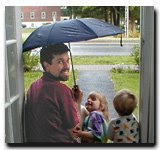Late blight has hit Maine and New England with a vengeance this year. Dr. Steven B. Johnson, University of Maine Cooperative Extension Crops Specialist, writes, "Late blight is caused by Phytophthora infestans, a fungus-like organism. Few plant diseases can rival the widespread misery and despair of late blight. Many tomato and potato growers are getting their first introduction to late blight. I’m afraid that many are unprepared for the level of destruction that this pathogen can cause."
Tomatoes and potatoes affected by blight show brown spots on leaves and stems that quickly spread, causing the entire plant to wilt and die. Otherwise healthy and vigorous plants can be overcome in a matter of days. Dr. Johnson's note (available from the MOFGA web site) explains how organic growers can control late blight with copper hydroxide.
Unfortunately, copper hydroxide is not suitable for most home gardeners. If you apply copper hydroxide, be very careful to read and follow the application notes. Ideally, you should have an eye-flush container available, and wear coveralls, chemical resistant gloves, shoes, socks and protective eye wear if you plan to reenter the treated area within 24 hours after application.
Instead of attempting to treat blight, most sources recommend that home gardeners pull blighted plants and either immediately bury them at least 12 inches deep or bag them in plastic and throw them in the garbage. Composting blighted plants above ground can spread the spores and prolong the infestation. A related strain of late blight was responsible for the Irish potato famine; this disease has been a serious problem for a long time!
The weather seems to be the main culprit for the widespread nature of the disease this year. The organism thrives in cool, wet weather. Another problem, according to a specialist quoted by The New York Times, may have been infected plants distributed by large retailers like Home Depot and Wal*Mart. Seedlings showing signs of blight were observed in at least one box store in New York state and remained on sale for more than a week. The distribution of infected seedlings may have exacerbated the outbreak this year.
Environmental Events
F.W. Horch summer hours: Mon by appointment, Tue-Sat 9:30-6, Sun Closed.
Thursday, August 13 -
Permaculture Design: Tools for Local Food Self Sufficiency, 7 pm, F.W. Horch, 56 Maine Street, Brunswick. Come learn how to turn your lawnscape into a sustainable food-producing gardenscape. Permaculture practitioners Noah Wentworth, Lisa Fernandes, and Ted Markow will lead the discussion. For more information, please call 729-4050. Free and open to the public.
Tuesday, August 18 -
Climate Action and Clean Energy Now, 7 pm, The Gulf of Maine Research Institute, 350 Commercial Street, Portland. Climate expert Dr. Joseph Romm, author of Hell and High Water and the editor of the most widely read climate blog in the country (http://www.climateprogress.org/) will speak on the movement toward a clean energy future. This event is one of 50 events to celebrate Natural Resource Council of Maine’s 50 years protecting the nature of Maine. Join NRCM for a reception from 6:00 to 7:00 p.m., with the presentation to follow at 7:00 p.m. The event is free and open to the public. You are encouraged to register online to help with planning. For more information, visit http://www.nrcm.org/.

